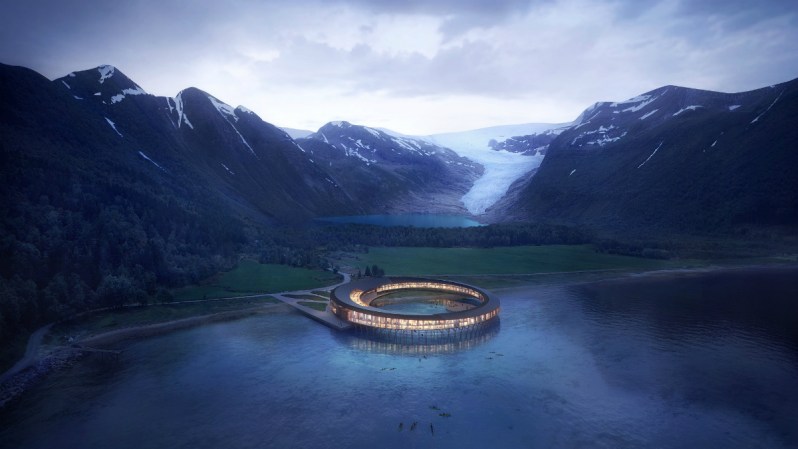
The Arctic Circle has sprouted forward-concept hotels beyond the realm of earthly design. Svart is no different.
Translating to colors “black” and “blue” in Norwegian, Svart was crafted by Snøhetta Designs to sit amid the deep blue-black Svartisen glacier. Built to use 85 percent less energy than a comparable modern resort, Svart may be pulling from ancestral roots for its nam,e but its bones are hyper-futuristic.
Built in compliance with the Powerhouse standard, Svart doesn’t only save juice, but produces its own. WTF is Powerhouse? A collaboration between Snøhetta, Entra, Skanska, the ZERO Emission Resource Organization, and Asplan Viak (aka a bunch of design firms and organizations that want to pioneer sustainable tourism).

Architects for Svart conducted an extensive mapping of how solar radiation behaves in relation to mountainous context to optimize the harvest of energy for this hotel location. The results prompted the hotel’s circular design and strategic placement of rooms, restaurants, and terraces. Meanwhile, the roof is clad with solar panels that were produced with clean hydro energy, shrinking the carbon footprint of Svart even further.
In the course of 60 years, Svart will generate more renewable energy than the total amount required to sustain daily operations and replace materials —a first for the region.
“Building in such a precious environment comes with some clear obligations in terms of preserving the natural beauty and the fauna and flora of the site,” says founding partner at Snøhetta, Kjetil Trædal Thorsen. “It was important for us to design a sustainable building that will leave a minimal environmental footprint on this beautiful Northern nature. Building an energy positive and low-impact hotel is an essential factor to create a sustainable tourist destination respecting the unique features of the plot; the rare plant species, the clean waters and the blue ice of the Svartisen glacier.”

Clandestine energy-savers double as modern aesthetic touches, like the façade, which protects against from the sun in the summer and allows for maximum insulation of the sun’s thermal energy in the winter.
Materials requiring minimal production, transport, building, and replacement have also been used to reach Powerhouse standards (the architectural term for this is “low embodied energy materials”). This means things derived from fossil fuels were a big no-no.
“The use of wood in construction and cladding minimizes the environmental impact of the building, and typically energy-intensive materials such as structural steel and concrete have been avoided as much as possible,” architects say. The hotel also uses geothermal wells that are connected to heat pumps, which heat the building.

Most noticeable from the outside is Svart’s circular shape, which is reminiscent of a sci-fi location on an unpopulated planet (or Apple’s new campus, whichever). Panoramic views of the Almlifjellet mountains, Holandsfjorden fjord water, and glowing Northern Lights envelope visitors in the solace and peace of the region. You can bet we’ll add it to our list of favorite minimalist hotels in Scandinavia.
The building was also inspired by a traditional rorbue house used seasonally by local fisherman and shaped like a drying fish, or fiskehjell. Weather-resistant wooden poles form the supporting base, stretching below the surface of the fjord and leaving a minimal print in the land. From a distance, one might believe Svort was a naturally-occurring phenomenon grown organically from the land.

Visitors can soon venture from the floating Eden for a day on the town as Svart is working to get an energy-neutral boat to shuttle visitors to and from the city of Bodø, known as “the gateway to the great north.” While you’re up there, visit the World’s Largest Underwater Restaurant.
Svart is a project created in collaboration with Arctic Adventure of Norway, a leader in sustainable tourism in Northern Norway. Well, check mate, Norway. We’re on our way.


